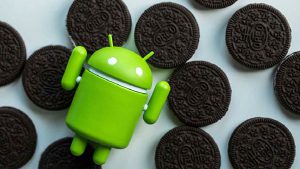 In addition to improving the security system, Android Oreo brought several new features for mobile software developers. Read further in the article.
In addition to improving the security system, Android Oreo brought several new features for mobile software developers. Read further in the article.
Unfortunately Android 8.1 hasn't brought a lot of changes for regular users compared to the release of 8.0. The main innovation of this version is the Pixel Visual core , a hidden and inactive chip for Pixel 2 and 2 XL. Let's take a look at it and other changes in the operating system.
Visual Core
Visual Core is Google's first custom processor for third-party developers. As the name suggests, this chip is used for image processing. It is also used in the company's flagships: Google Pixel 3 and 3 XL. The company does not deny the possibility of the chip appearing in other smartphones.
With the release of Android 8.1, the chip became available for work in devices of its own production. As a result, the overall quality of the photographs has improved. The new chip significantly improves photo quality with HDR + enabled. By taking a burst of photos in less than a second, cameras that support HDR + are much better at capturing dark and light parts than cameras without it.
Cameras with HDR + get a significant improvement in photo quality due to the new chip. Photo processing on a smartphone with Visual Core is 5 times faster than with previous generations of processors. You may not notice this, but you will notice increased detail in the image taken in low light.

Left picture without HDR +, right – with HDR +
Previously, you could only take pictures with HDR + enabled through the Google Photos app. Now even third-party camera apps that use the Android API – cameras like Instagram and Snapchat can shoot in HDR + to improve the quality of the resulting photos.
to the content
Neural Network API
Any device with Android 8.1 support can use its own developed neural network API. The API is primarily for developers. NNAPI is used to activate machine learning on mobile devices. The API is designed to provide a basic level of functionality for machine learning frameworks such as TensorFlow Lite and others.

What does this give the user? The emergence of applications with advanced artificial intelligence that can recognize foreign speech.
to the content
Standard charge indicator Bluetooth – devices
Are you tired of constant charging problems Bluetooth – your headset? In Android 8.1 and above, a charge indicator Bluetooth will appear – devices, which can be checked in the settings Bluetooth. Of course, it would be convenient if the indicator was located along with all the icons in the status bar, but even this option will make your life easier.
to the content
Screen upgrade
Some smartphones, such as the Pixel 2 XL, have one of the most common flaws OLED – technology – display burnout. Screen burn-in occurs when an object on the screen remains stationary for a long time (for example, a clock).
“Disease” appears as faint outline of controls visible against a gray background. Google has done a lot of work on their P OLED – screens before the release of Android 8.1. Did it work? Yes. Now the screens do not burn out.
to the content
Updated shell
The interface remained unchanged, but a couple of interesting things were discovered. For example, Pixel Launcher is a new home screen. It makes it much easier to use Google services and downloaded apps. You can return to the standard interface if you wish. Many new themes have also been added.
Android 8.1 is one hundred percent step forward. In addition to the innovations listed above, the company has developed the Project Treble utility designed to solve the problem of slow downloading of updates.
Before Treble, the first version of which appeared back in 8.1 when Google released an OS update, OEMs such as Mediatek and Qualcomm had to create new drivers in order for devices to work normally on this system. Then the smartphone makers started adding their own features. As a result, users had to arrange “dancing with tambourines” for the new version to work on their phone.
Project Treble made future updates easier and faster.
Working with OEM chipset manufacturers, all released models are verified through the Vendor Test Suite. In short, Google is “dropping” a couple of extra pounds, which is why updates start loading much faster, without unnecessary ballast.
